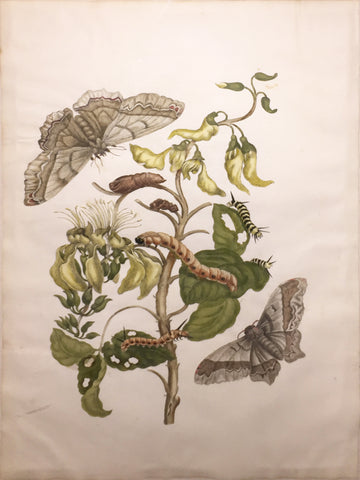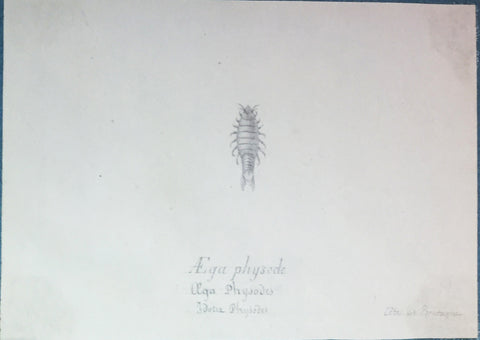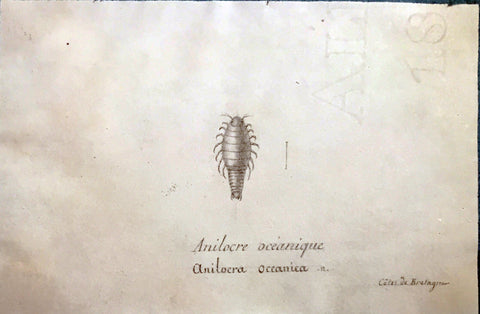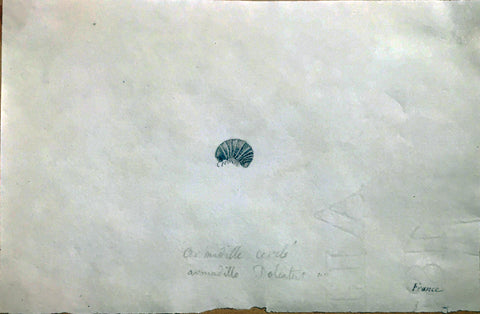
Maria Sibylla Merian (German, 1647-1717), Plate 11. Coral Bean Tree and Emperor.
Maria Sibylla Merian (German, 1647-1717)
“Plate 11. Coral Bean Tree and Emperor. ”
from The Insects of Surinam
Watercolor and bodycolor with gum arabic over lightly etched outlines on paper
Amsterdam, 1705
Paper size: 20 1/4 x 14 in.
Transfer-print watercolors from The Insects of Surinam
This plate was engraved by Maria Sibylla Merian herself. The coral bean tree (Eriythrina glauca), a papilionaceous flower, has a great peculiarity: the inflorescence, or clusters of blossoms, are too heavy for their thin stalks, and they hang down - Merian illustrated this observation in the fruit on the left. The planters of Surinam also know the plant as “koffiemama,” because it affords a gentle shade over the coffee plantations. Its barley-like seeds are also edible. The caterpillar and the emperor (Arsenura armida Cr.) seen here were drawn in Surinam and according to Merian’s description, these caterpillars represented stages of the same moth, despite the difference in appearance. “I found many of theses caterpillars on wild trees; they were light-yellow and black striped, and once they had slipped out of their skin they turned orange-yellow with round, black spots; and when they had shed their skin a second time they lost their black markings. They turned into brown date-pits on April 14th, and on June 12th such large moths emerged. I placed this metamorphosis on a palisade tree, which grows in the forest and from which people used the wood to build houses, No. 11 of my [book of] Surinamese insects.”
Descriptions of each plant adapted from J.Harvey’s commentary to the Folio Society facsimile of the Surinam Album (London, 2006) and Merian’s text for the Insects of Surinam.
One glimpse of any of Merian’s transfer-print watercolors from the Insects of Surinam reveals the main reasons for such celebration. Even to those who do not know of her work, this is a stunning sight. Her colors are alternately subtle and vibrant, capturing the quality of her subjects with striking naturalism. Yet while she maintains a scientist’s eye for precision, her creative decisions and compositions give these images a style that is distinctly hers. Each image demonstrates Merian’s masterful grasp of detail and nuance, as well as her outstanding ability to combine science and art. Equally significant, to early 18th century Europeans, her illustrations represented the first views of these American plants and insects.
These spectacular examples of her work are from one of a very few transfer-print watercolor volumes known to exist. Merian herself prepared the volume. After an uncolored print was made, she applied dampened paper to it, pressing by hand to create an image of the print in reverse. In this volume, she chose to block out the plate numbers and then add by hand, to some images, numbers, and notations. Merian then painstakingly watercolored the dried paper herself, ensuring that the colors were true to the specimens she had seen in South America, and also allowing her style to emerge with the greatest clarity. The volume was not meant for sale, and its intended purpose cannot be known with any certainty. Perhaps it was created as a gift for a wealthy and important patron, perhaps Merian meant to keep it herself. What can be stated without a doubt is that these splendid images represent a unique opportunity to acquire original works by an artist who broke barriers as a woman, as a scientist and artist, and whose accomplishments are no less impressive today than they were in her time.
Please feel free to contact us with questions by phone at 215.735.8811,
or by email at loricohen@aradergalleries.
We Also Recommend





